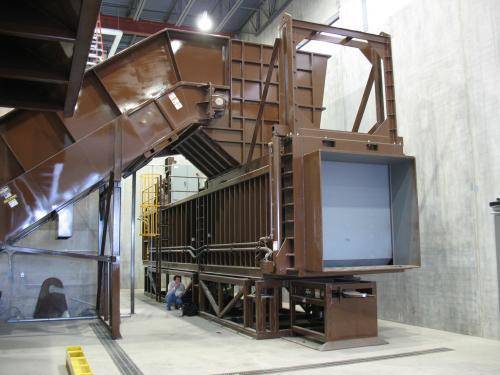Baler Rental Services for Your Hazardous Waste Demands
Baler Rental Services for Your Hazardous Waste Demands
Blog Article
Evaluating the Cost-Effectiveness and Environmental Advantages of Purchasing Advanced Waste Equipment for Companies and Organizations
The choice to purchase advanced waste equipment is progressively critical for companies intending to boost both their financial and ecological performance. Evaluating the cost-effectiveness of such investments discloses possibility for significant savings, particularly through decreased operational costs and enhanced resource administration. The environmental benefits-- such as reduced landfill usage and reduced exhausts-- add to an extra lasting functional structure. Yet, the effects of this financial investment prolong past simple numbers, elevating vital inquiries about long-term viability and regulatory conformity. As companies browse these complexities, the path onward comes to be appealing.
Recognizing Advanced Waste Tools
Advanced waste devices encompasses a selection of cutting-edge innovations created to boost waste monitoring procedures efficiently. This tools consists of automated arranging systems, compactors, shredders, and progressed reusing equipment, all intended at enhancing efficiency and minimizing ecological effect. The key goal of innovative waste equipment is to simplify the collection, processing, and disposal of waste materials, thereby reducing labor costs and enhancing operational efficiency.
One remarkable innovation is making use of wise waste containers equipped with sensors that keep an eye on waste degrees and optimize collection paths. This not just reduces unnecessary pick-ups yet also reduces gas intake and greenhouse gas emissions. Furthermore, progressed shredders and compactors facilitate the reduction of waste quantity, which is essential for making the most of land fill space and enhancing recycling efforts.
In addition, the integration of expert system and equipment learning in waste monitoring systems permits improved information analytics, bring about educated decision-making and boosted source appropriation. By employing these state-of-the-art technologies, companies and organizations can achieve significant improvements in waste management processes, ultimately resulting in better sustainability outcomes and conformity with governing criteria.
Price Evaluation of Financial Investment
Reviewing the price evaluation of financial investment in advanced waste equipment is vital for organizations seeking to improve their waste monitoring practices. An extensive price analysis entails analyzing both the preliminary resources expense and ongoing operational costs connected with acquiring and preserving such devices. This includes not just the acquisition cost however likewise installation prices, training for employees, and possible downtime throughout the shift period.
Organizations have to additionally think about the different types of advanced waste equipment readily available, such as compactors, shredders, and reusing systems, each with distinct rates frameworks. Additionally, the financial implications of tools effectiveness ought to be evaluated, as extra effective systems may lead to lowered garbage disposal charges and lower source intake.
Additionally, prospective funding resources and motivations, such as government gives or tax credits, can dramatically affect the total expense evaluation. By carrying out a thorough assessment of these variables, organizations can make informed decisions that straighten with their sustainability goals while ensuring an audio monetary investment (baler rental). Eventually, a detailed cost analysis lays the structure for understanding the economic feasibility and strategic benefits of buying innovative waste monitoring modern technologies

Long-Term Cost Savings Potential
Purchasing advanced waste devices not only includes an upfront monetary dedication however also unlocks to substantial long-term financial savings potential. Services and organizations that apply such technology can expect to see a decrease in operational expenses with time. Advanced waste equipment commonly streamlines waste administration procedures, resulting in lowered labor costs and enhanced effectiveness.
By automating waste sorting and handling, organizations decrease the demand for manual labor, allowing personnel to concentrate on more value-added activities. Boosted waste management systems can reduce the quantity of waste that finishes up in land fills, which consequently decreases disposal costs and possible regulatory fines associated with waste mismanagement - baler rental.
Along with guide expense financial savings, organizations can also experience improved income chances. For circumstances, reusing programs can generate income from the sale of retrieved products. Furthermore, a dedication to innovative waste management can improve a business's online reputation, attracting environmentally mindful consumers and clients, which may cause raised market share.
Environmental Impact Assessment
How do sophisticated waste administration systems contribute to environmental sustainability? The execution of these systems permits for the efficient separation of recyclable products, which can substantially reduce the quantity of waste routed to garbage dumps, therefore decreasing methane exhausts and other harmful contaminants linked with waste decomposition.
Furthermore, progressed waste administration remedies are designed to minimize power consumption and improve operational effectiveness. For example, energy-efficient equipment not only decreases article source total energy use yet also reduces greenhouse gas discharges, straightening with global sustainability goals. Furthermore, the adoption of these systems can foster a culture of ecological obligation within companies, urging employees to participate in sustainable methods.
Carrying out an extensive environmental impact assessment of these systems discloses their possible benefits, including boosted air see this and water top quality, biodiversity conservation, and improved neighborhood health and wellness. Ultimately, purchasing advanced waste monitoring modern technology stands for a critical technique to accomplishing long-lasting environmental sustainability while promoting financial feasibility.
Study and Real-World Examples
Numerous study illustrate the performance of advanced waste monitoring systems in advertising ecological sustainability throughout different markets. A leading production business embraced automated waste sorting technology, which resulted in a 40% decrease in land fill waste within the initial year. This financial investment not only improved operational effectiveness but also dramatically lowered disposal expenses, showcasing a solid roi.
In the friendliness industry, a significant hotel chain carried out an innovative food waste digestion system that transformed natural waste right into tidy power. This campaign lowered waste outcome by 50% and offered the resort with a lasting energy resource, highlighting both economic and ecological benefits.

These real-world instances demonstrate that organizations can accomplish substantial price financial savings while enhancing their sustainability accounts with tactical financial investments in sophisticated waste management modern technologies. As these instance research studies disclose, the combination of ingenious waste remedies is not just feasible yet likewise important for modern-day business intending to line up with environmental requirements and customer assumptions.
Verdict
Investment in sophisticated waste devices arises as a tactical decision for services looking for to boost cost-effectiveness and ecological sustainability. By automating waste sorting and leveraging smart innovations, companies can attain significant reductions in functional expenses and land fill payments.
Report this page